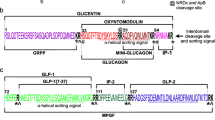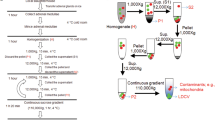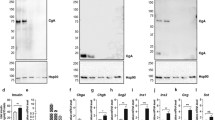Abstract
Cytochrome c oxidase (COX) complex is an integral part of the electron transport chain. Three subunits of this complex (COX I, COX II and COX III) are encoded by mitochondrial (mit-) DNA. High-resolution immunogold electron microscopy has been used to study the subcellular localization of COX I and COX II in rat tissue sections, embedded in LR Gold resin, using monoclonal antibodies for these proteins. Immunofluorescence labeling of BS-C-1 monkey kidney cells with these antibodies showed characteristic mitochondrial labeling. In immunogold labeling studies, the COX I and COX II antibodies showed strong and specific mitochondrial labeling in the liver, kidney, heart and pancreas. However, in rat pancreatic acinar tissue, in addition to mitochondrial labeling, strong and specific labeling was also observed in the zymogen granules (ZGs). In the anterior pituitary, strong labeling with these antibodies was seen in the growth hormone secretory granules. In contrast to these compartments, the COX I or COX II antibodies showed only minimal labeling (five- to tenfold lower) of the cytoplasm, endoplasmic reticulum and the nucleus. Strong labeling with the COX I or COX II antibodies was also observed in highly purified ZGs from bovine pancreas. The observed labeling, in all cases, was completely abolished upon omission of the primary antibodies. These results provide evidence that, similar to a number of other recently studied mit-proteins, COX I and COX II are also present outside the mitochondria. The presence of mit-DNA encoded COX I and COX II in extramitochondrial compartments, provides strong evidence that proteins can exit, or are exported, from the mitochondria. Although the mechanisms responsible for protein exit/export remain to be elucidated, these results raise fundamental questions concerning the roles of mitochondria and mitochondrial proteins in diverse cellular processes in different compartments.








Similar content being viewed by others
References
Bradbury MW, Berk PD (2000) Mitochondrial aspartate aminotransferase: direction of a single protein with two distinct functions to two subcellular sites does not require alternative splicing of the mRNA. Biochem J 345(Pt 3):423–427
Brokstad KA, Kalland KH, Russell WC, Matthews DA (2001) Mitochondrial protein p32 can accumulate in the nucleus. Biochem Biophys Res Commun 281:1161–1169
Brudzynski K, Martinez V, Gupta RS (1992) Immunocytochemical localization of heat-shock protein 60-related protein in beta-cell secretory granules and its altered distribution in non-obese diabetic mice. Diabetologia 35:316–324
Bulger RE (1988) The urinary system. In: Weiss L (ed) Cell and tissue biology: a textbook of histology. Urban& Schwarzenberg, Baltimore, pp 815–850
Capaldi RA (2000) The changing face of mitochondrial research [editorial]. Trends Biochem Sci 25:212–214
Capaldi RA, Marusich MF, Taanman JW (1995) Mammalian cytochrome- c oxidase: characterization of enzyme and immunological detection of subunits in tissue extracts and whole cells. Methods Enzymol 260:117–132
Cavanagh AC, Morton H (1994) The purification of early-pregnancy factor to homogeneity from human platelets and identification as chaperonin 10. Eur J Biochem 222:551–560
Cechetto JD, Gupta RS (2000) Immunoelectron microscopy provides evidence that tumor necrosis factor receptor-associated protein 1 (TRAP-1) is a mitochondrial protein which also localizes at specific extramitochondrial sites. Exp Cell Res 260:30–39
Cechetto JD, Soltys BJ, Gupta RS (2000) Localization of mitochondrial 60-kD heat shock chaperonin protein (Hsp60) in pituitary growth hormone secretory granules and pancreatic zymogen granules. J Histochem Cytochem 48:45–56
Cechetto JD, Sadacharan SK, Berk PD, Gupta RS (2002) Immunogold localization of mitochondrial aspartate aminotransferase in mitochondria and on the cell surface in normal rat tissues. Histol Histopathol 17:353–364
Felts SJ, Owen BA, Nguyen P, Trepel J, Donner DB, Toft DO (2000) The hsp90-related protein TRAP1 is a mitochondrial protein with distinct functional properties. J Biol Chem 275:3305–3312
Ghebrehiwet B, Lim BL, Kumar R, Feng X, Peerschke EI (2001) gC1q-R/p33, a member of a new class of multifunctional and multicompartmental cellular proteins, is involved in inflammation and infection. Immunol Rev 180:65–77
Gingrich JR, Pelkey KA, Fam SR, Huang Y, Petralia RS, Wenthold RJ, Salter MW (2004) Unique domain anchoring of Src to synaptic NMDA receptors via the mitochondrial protein NADH dehydrogenase subunit 2. Proc Natl Acad Sci USA 101:6237–6242
Glick B, Schatz G (1991) Import of proteins into mitochondria. Annu Rev Genet 25:21–44
Haraguchi CM, Mabuchi T, Yokota S (2003) Localization of a mitochondrial type of NADP-dependent isocitrate dehydrogenase in kidney and heart of rat: an immunocytochemical and biochemical study. J Histochem Cytochem 51:215–226
Holland IB (2004) Translocation of bacterial proteins—an overview. Biochim Biophys Acta 1694:5–16
Hubner S, Bahr C, Gossmann H, Efthymiadis A, Drenckhahn D (2003) Mitochondrial and nuclear localization of kanadaptin. Eur J Cell Biol 82:240–252
Jamieson JD, Palade GE (1967) Intracellular transport of secretory proteins in the pancreatic exocrine cell. II. Transport to condensing vacuoles and zymogen granules. J Cell Biol 34:597–615
Jones M, Gupta RS, Englesberg E (1994) Enhancement in amount of P1 (hsp60) in mutants of Chinese hamster ovary (CHO-K1) cells exhibiting increases in the A system of amino acid transport. Proc Natl Acad Sci USA 91:858–862
Kato S, Miyabayashi S, Ohi R, Nakagawa H, Abe J, Yamamoto K, Watanabe S, Tada K (1990) Chronic pancreatitis in muscular cytochrome c oxidase deficiency. J Pediatr Gastroenterol Nutr 11:549–552
Kaul SC, Taira K, Pereira-Smith OM, Wadhwa R (2002) Mortalin: present and prospective. Exp Gerontol 37:1157–1164
Kotti TJ, Savolainen K, Helander HM, Yagi A, Novikov DK, Kalkkinen N, Conzelmann E, Hiltunen JK, Schmitz W (2000) In mouse alpha-methylacyl-CoA racemase, the same gene product is simultaneously located in mitochondria and peroxisomes. J Biol Chem 275:20887–20895
Lakshmipathy U, Campbell C (1999) The human DNA ligase III gene encodes nuclear and mitochondrial proteins. Mol Cell Biol 19:3869–3876
Loveland B, Wang CR, Yonekawa H, Hermel E, Lindahl KF (1990) Maternally transmitted histocompatibility antigen of mice: a hydrophobic peptide of a mitochondrially encoded protein. Cell 60:971–980
Meertens LM, Miyata KS, Cechetto JD, Rachubinski RA, Capone JP (1998) A mitochondrial ketogenic enzyme regulates its gene expression by association with the nuclear hormone receptor PPARalpha. EMBO J 17:6972–6978
Morton H, Cavanagh AC, Athanasas-Platsis S, Quinn KA, Rolfe BE (1992) Early pregnancy factor has immunosuppressive and growth factor properties. Reprod Fertil Dev 4:411–422
Mueller JC, Andreoli C, Prokisch H, Meitinger T (2004) Mechanisms for multiple intracellular localization of human mitochondrial proteins. Mitochondrion 3:315–325
Neupert W (1997) Protein import into mitochondria. Annu Rev Biochem 66:863–917
Palade G (1975) Intracellular aspects of the process of protein synthesis. Science 189:347–358
Passarella S, Marra E, Atlante A, Barile M, Doonan S, Quagliariello E (1990) Uptake of aspartate aminotransferase into mitochondria in vitro causes efflux of malate dehydrogenase and vice versa. Biochim Biophys Acta 1022:273–282
Pfanner N, Neupert W (1990) The mitochondrial protein import apparatus. Annu Rev Biochem 59:331–353
Poyton RO, Duhl DMJ, Clarkson GHD (1992) Protein export from the mitochondrial matrix. Trends Cell Biol 2:369–375
Ran Q, Wadhwa R, Kawai R, Kaul SC, Sifers RN, Bick RJ, Smith JR, Pereira-Smith OM (2000) Extramitochondrial localization of mortalin/mthsp70/PBP74/GRP75. Biochem Biophys Res Commun 275:174–179
Sadacharan SK, Cavanagh AC, Gupta RS (2001) Immunoelectron microscopy provides evidence for the presence of mitochondrial heat shock 10-kDa protein (chaperonin 10) in red blood cells and a variety of secretory granules. Histochem Cell Biol 116:507–517
Sass E, Blachinsky E, Karniely S, Pines O (2001) Mitochondrial and cytosolic isoforms of yeast fumarase are derivatives of a single translation product and have identical amino termini. J Biol Chem 276:46111–46117
Scheffler IE (2001) A century of mitochondrial research: achievments and perspectives. Mitochondrion 1:3–31
Schon EA (2000) Mitochondrial genetics and disease. Trends Biochem Sci 25:555–560
Shoubridge EA (2001) Nuclear gene defects in respiratory chain disorders. Semin Neurol 21:261–267
Singh B, Soltys BJ, Wu ZC, Patel HV, Freeman KB, Gupta RS (1997) Cloning and some novel characteristics of mitochondrial Hsp70 from Chinese hamster cells. Exp Cell Res 234:205–216
Smalheiser NR (1996) Proteins in unexpected locations. Mol Biol Cell 7:1003–1014
Soltys BJ, Gupta RS (1992) Interrelationships of endoplasmic reticulum, mitochondria, intermediate filaments, and microtubules—a quadruple fluorescence labeling study. Biochem Cell Biol 70:1174–1186
Soltys BJ, Gupta RS (1996) Immunoelectron microscopic localization of the 60-kDa heat shock chaperonin protein (Hsp60) in mammalian cells. Exp Cell Res 222:16–27
Soltys BJ, Gupta RS (1998) Mitochondrial molecular chaperones Hsp60 and mHsp70: are their roles restricted to mitochondria? Handb Exp Pharmacol 136:69–100
Soltys BJ, Gupta RS (1999) Mitochondrial-matrix proteins at unexpected locations: are they exported? Trends Biochem Sci 24:174–177
Soltys BJ, Gupta RS (2000) Mitochondrial proteins at unexpected cellular locations: export of proteins from mitochondria from an evolutionary perspective. Int Rev Cytol 194:133–196
Soltys BJ, Kang D, Gupta RS (2000) Localization of P32 protein (gC1q-R) in mitochondria and at specific extramitochondrial locations in normal tissues. Histochem Cell Biol 114:245–255
Soltys BJ, Andrews DA, Jemmerson R, Gupta RS (2001) Cytochrome c localizes in secretory granules in pancreas and anterior pituitary. Cell Biol Int 25:331–338
Stein I, Peleg Y, Even-Ram S, Pines O (1994) The single translation product of the FUM1 gene (fumarase) is processed in mitochondria before being distributed between the cytosol and mitochondria in Saccharomyces cerevisiae. Mol Cell Biol 14:4770–4778
Strobel G, Zollner A, Angermayr M, Bandlow W (2002) Competition of spontaneous protein folding and mitochondrial import causes dual subcellular location of major adenylate kinase. Mol Biol Cell 13:1439–1448
Taanman JW, Hall RE, Tang C, Marusich MF, Kennaway NG, Capaldi RA (1993) Tissue distribution of cytochrome c oxidase isoforms in mammals. Characterization with monoclonal and polyclonal antibodies. Biochim Biophys Acta 1225:95–100
Taanman JW, Burton MD, Marusich MF, Kennaway NG, Capaldi RA (1996) Subunit specific monoclonal antibodies show different steady-state levels of various cytochrome- c oxidase subunits in chronic progressive external ophthalmoplegia. Biochim Biophys Acta 1315:199–207
Thevenod F, Gasser KW, Hopfer U (1990) Dual modulation of chloride conductance by nucleotides in pancreatic and parotid zymogen granules. Biochem J 272:119–126
Valgardsdottir R, Brede G, Eide LG, Frengen E, Prydz H (2001) Cloning and characterization of MDDX28, a putative dead-box helicase with mitochondrial and nuclear localization. J Biol Chem 276:32056–32063
Velez-Granell CS, Arias AE, Torres-Ruiz JA, Bendayan M (1994) Molecular chaperones in pancreatic tissue: the presence of cpn10, cpn60 and hsp70 in distinct compartments along the secretory pathway of the acinar cells. J Cell Sci 107(Pt 3):539–549
Villegas J, Araya P, Bustos-Obregon E, Burzio LO (2002) Localization of the 16S mitochondrial rRNA in the nucleus of mammalian spermatogenic cells. Mol Hum Reprod 8:977–983
Wadhwa R, Kaul SC, Ikawa Y, Sugimoto Y (1993) Identification of a novel member of mouse hsp70 family. Its association with cellular mortal phenotype. J Biol Chem 268:6615–6621
Wallace DC (1999) Mitochondrial diseases in man and mouse. Science 283:1482–1488
Yang SH, Liu R, Perez EJ, Wen Y, Stevens SM Jr, Valencia T, Brun-Zinkernagel AM, Prokai L, Will Y, Dykens J, Koulen P, Simpkins JW (2004) Mitochondrial localization of estrogen receptor beta. Proc Natl Acad Sci USA 101:4130–4135
Acknowledgements
This work was supported by a research grant from the Canadian Institute of Health Research.
Author information
Authors and Affiliations
Corresponding author
Rights and permissions
About this article
Cite this article
Sadacharan, S.K., Singh, B., Bowes, T. et al. Localization of mitochondrial DNA encoded cytochrome c oxidase subunits I and II in rat pancreatic zymogen granules and pituitary growth hormone granules. Histochem Cell Biol 124, 409–421 (2005). https://doi.org/10.1007/s00418-005-0056-2
Accepted:
Published:
Issue Date:
DOI: https://doi.org/10.1007/s00418-005-0056-2




